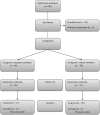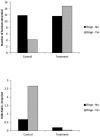Motivational enhancement mitigates the effects of problematic alcohol use on treatment compliance among partner violent offenders: Results of a randomized clinical trial
- PMID: 26009782
- PMCID: PMC4881299
- DOI: 10.1037/a0039345
Motivational enhancement mitigates the effects of problematic alcohol use on treatment compliance among partner violent offenders: Results of a randomized clinical trial
Abstract
Objective: Treatment programs for intimate partner violence (IPV) evidence high rates of noncompliance, which is associated with repeat offending. Problematic alcohol use is reported in approximately half of all partner violent offenders and represents a strong risk factor for treatment noncompliance. However, previous research with IPV offenders mandated to treatment has not evaluated methods to mitigate the effects of alcohol misuse on treatment compliance.
Method: In the current study, 60 male IPV offenders (25 binge drinkers) were randomly assigned to a single-session brief motivational interview (BMI) or control intervention prior to treatment commencement. Treatment compliance data were collected 6 months later.
Results: Findings indicated that binge drinkers had lower treatment compliance than non-binge-drinking participants, and that binge-drinking BMI participants attended more treatment sessions and evidenced lower dropout rates than binge-drinking control participants.
Conclusions: Findings highlight the importance of individualized treatment planning for IPV offenders in order to maximize available resources while accommodating the needs of males at greatest risk for noncompliance and continued violence.
(c) 2015 APA, all rights reserved).
Figures
References
-
- Babcock J, Green C, Robie C. Does batterers' treatment work? A meta-analytic review of domestic violence treatment. Clinical Psychology Review. 2004;23:1023–1053. - PubMed
-
- Berman A, Bergman H, Palmstierna T, Schlyter F. Evaluation of the Drug Use Disorders Identification Test (DUDIT) in criminal justice and detoxification settings and in a Swedish population sample. European Addiction Research. 2005;11:22–31. - PubMed
-
- Begun A, Murphy C, Bolt D, Weinstein B, Strodthoff T, Short L, Shelley G. Characteristics of the Safe at Home instrument for assessing readiness to change intimate partner violence. Research on Social Work Practice. 2003;13:80–107.
-
- Cadsky O, Hanson RK, Crawford M, Lalonde C. Attrition from a male batterer treatment program: Client-treatment congruence and lifestyle instability. Violence and Victims. 1996;11:51–64. - PubMed
-
- Connors GJ, Walitzer KS, Dermen KH. Preparing clients for alcoholism treatment: Effects on treatment participation and outcomes. Journal of Consulting and Clinical Psychology. 2002;70:1161–1169. - PubMed
Publication types
MeSH terms
Grants and funding
LinkOut - more resources
Full Text Sources
Other Literature Sources
Medical



